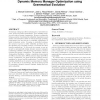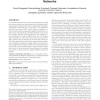579 search results - page 72 / 116 » Energy distribution control in wireless sensor networks thro... |
GECCO
2010
Springer
14 years 18 days ago
2010
Springer
Technology scaling has offered advantages to embedded systems, such as increased performance, more available memory and reduced energy consumption. However, scaling also brings a...
SIGCOMM
2006
ACM
14 years 1 months ago
2006
ACM
In a wireless sensor network of N nodes transmitting data to a single base station, possibly over multiple hops, what distributed mechanisms should be implemented in order to dyna...
INFOCOM
2002
IEEE
14 years 22 days ago
2002
IEEE
—Advances in microsensor and radio technology will enable small but smart sensors to be deployed for a wide range of environmental monitoring applications. The low per-node cost ...
TMC
2010
13 years 6 months ago
2010
– While a lot of existing research attempts to extend the lifetime of a wireless sensor network (WSN) by designing energy efficient networking protocols, the impact of random dev...
WINET
2011
13 years 2 months ago
2011
Sleep scheduling, which is putting some sensor nodes into sleep mode without harming network functionality, is a common method to reduce energy consumption in dense wireless sensor...


